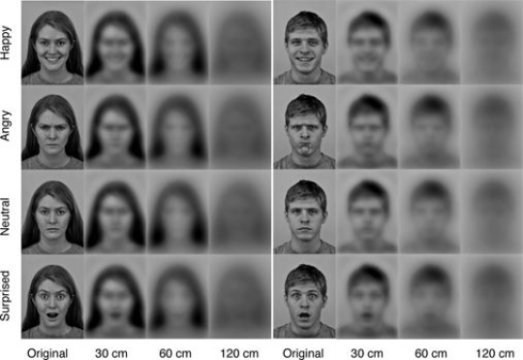Phoenix Technology News July 8th news, according to the Science Daily report, newborn babies can see the expression of their parents at 30 centimeters distance. For the first time, researchers reconstructed the infant's visual perception of the world. By combining technology, mathematics, and previous knowledge of baby's visual perception, the researchers have successfully shown to adult viewers how much new babies can actually see. The results showed that 2-3 days of babies could be at a distance of 30 centimeters - a typical distance between the baby and the care of her mother - the perception of a face, or even a sense of emotional facial expression. If the distance is increased to 60 cm, the visual image will become too vague to perceive the face and expression. The study was conducted by researchers at the school of psychology at the University of Oslo, Norway, with colleagues from University of Uppsala in Sweden and the Stockholm solar eclipse optical company.

2-3 days babies can reach a distance of 30 centimeters - this is the typical distance between babies and caring for her mother
this study fills the gap in the knowledge of the baby's visual world, which has lasted for decades. This may help explain that newborn babies can mimic the facial expressions of adults within a few days or weeks of birth, and their vision is not fully developed to perceive the details of the surrounding environment. The key word is exercise.
before that, when researchers tried to accurately estimate what newborn babies could see, they used still pictures. But the real world is dynamic. Our idea is to use motion pictures. Svane Magnuson, an honorary professor at the school of psychology at University of Oslo, said (Svein Magnussen).
in his early career, Magnuson studied human visual perception. On the day 15 years ago, he and his colleagues discussed whether the newborns could perceive the facial expressions of the surrounding people. Researchers say that if babies can see and imitate facial expressions, the reason behind them may be the movement of faces.
"at that time we had neither equipment nor technical ability to test our ideas. Only a year ago did we retest the idea. So our result is based on an old and not tested idea. What causes facial expressions to be understood by babies? For testing, researchers must combine modern simulation techniques with previous insights on infant vision. We have received a lot of information about the contrast sensitivity and spatial resolution of young infants, which are based on behavioral studies conducted in 1980s. At that time, researchers found that displaying images of people in a unified gray background led them to focus their attention on the portrait.
"the study used a portrait composed of black and white stripes. By choosing the specific stripe width and frequency, the background looks uniform and gray, which makes the baby not focus on the background. By changing the width and frequency of the human image, the researchers can determine the contrast and spatial resolution that the baby needs to focus on the human image. " Magnuson said.
in other words, researchers can get accurate information about newborn vision. But what is unknown to them is the actual consequences of these information. For example, does it mean that newborns can see the look of their adults looking down at them?
recognition of certain moving images is easier than blurred still pictures. The researchers recorded facial videos that were switched between different emotional expressions to filter out information we could not make use of known newborn babies. They then asked adults to watch these videos. If an adult can not determine a facial expression, then it can be assumed that the newborn can not identify the facial expression.
when watching video at a distance of 30 cm, the probability of adult adults correctly identifying faces is about 3/4. When the distance increased to 120 cm, the discrimination rate of the subjects was almost the same as that of random guess. This means that the ability of newborn babies to distinguish facial expression based on available visual information reaches the limit of 30 centimeters.
"we must remember that it is very important that we only investigate what the newborn can see, not what they can understand." Magnuson pointed out that. Previous studies of
rebuilt the visual reality of the newborn, for example, in students' textbooks, they often rely on shooting a normal picture and blurring it. Magnuson admitted that he was surprised that no one had used the details of infant vision perception before him. So this is the first time we have specifically estimated the visual information that newborn babies can obtain.
Magnuson and his colleagues were very happy to finally be able to test their idea 15 years ago. As for further exploring their results, they are prepared to leave them to others. "Everyone involved in the study is now involved in other research areas. Our current situation is that we have laid the foundation. If anyone wants to continue this research, it's entirely up to them. " Magnuson said. (compiling / Yan Yan Liu Xing)